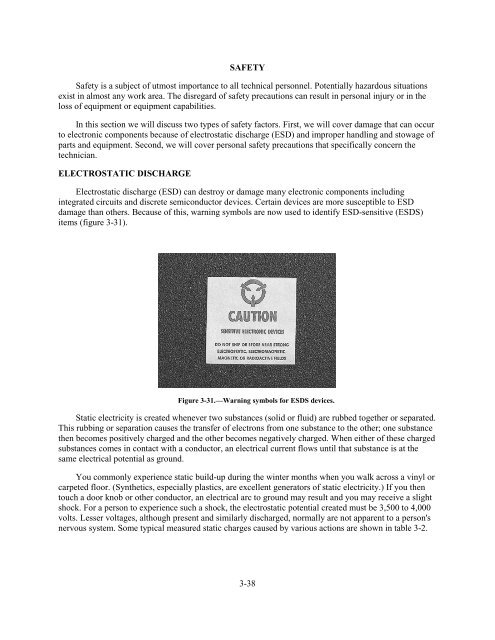Navy Electricity and Electronics Training Series - Historic Naval ...
Navy Electricity and Electronics Training Series - Historic Naval ...
Navy Electricity and Electronics Training Series - Historic Naval ...
You also want an ePaper? Increase the reach of your titles
YUMPU automatically turns print PDFs into web optimized ePapers that Google loves.
SAFETYSafety is a subject of utmost importance to all technical personnel. Potentially hazardous situationsexist in almost any work area. The disregard of safety precautions can result in personal injury or in theloss of equipment or equipment capabilities.In this section we will discuss two types of safety factors. First, we will cover damage that can occurto electronic components because of electrostatic discharge (ESD) <strong>and</strong> improper h<strong>and</strong>ling <strong>and</strong> stowage ofparts <strong>and</strong> equipment. Second, we will cover personal safety precautions that specifically concern thetechnician.ELECTROSTATIC DISCHARGEElectrostatic discharge (ESD) can destroy or damage many electronic components includingintegrated circuits <strong>and</strong> discrete semiconductor devices. Certain devices are more susceptible to ESDdamage than others. Because of this, warning symbols are now used to identify ESD-sensitive (ESDS)items (figure 3-31).Figure 3-31.—Warning symbols for ESDS devices.Static electricity is created whenever two substances (solid or fluid) are rubbed together or separated.This rubbing or separation causes the transfer of electrons from one substance to the other; one substancethen becomes positively charged <strong>and</strong> the other becomes negatively charged. When either of these chargedsubstances comes in contact with a conductor, an electrical current flows until that substance is at thesame electrical potential as ground.You commonly experience static build-up during the winter months when you walk across a vinyl orcarpeted floor. (Synthetics, especially plastics, are excellent generators of static electricity.) If you thentouch a door knob or other conductor, an electrical arc to ground may result <strong>and</strong> you may receive a slightshock. For a person to experience such a shock, the electrostatic potential created must be 3,500 to 4,000volts. Lesser voltages, although present <strong>and</strong> similarly discharged, normally are not apparent to a person'snervous system. Some typical measured static charges caused by various actions are shown in table 3-2.3-38

















